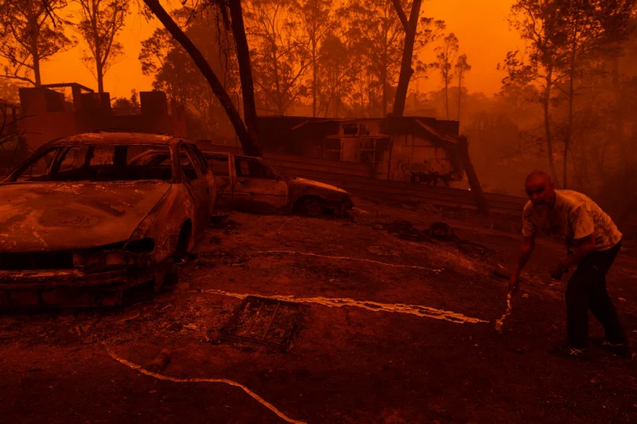Australia's extreme bushfire season was at least 30 per cent more likely than a century ago because of climate change, and the risks of a repeat will rise four-fold if global temperatures exceed a two-degree increase.
The World Weather Attribution group, an international collaboration including Australian scientists, used peer-reviewed methods to assess whether human-induced global warming altered the likelihood of bushfires of the intensity experienced during the 2019-20 summer.
 |
| Fire and Rescue NSW firefighters escape flames from the Gospers Mountain fire north-west of Sydney in mid-December 2019. Credit: Nick Moir |
The scientists examined the probability of extreme heat and drought and a fire weather index as severe as those just experienced compared with Australia's climate of about 1900.
The bushfires drew international attention in part because of the "unprecedented nature of this event", with millions of hectares burned, 5900 residential and public structures destroyed and at least 34 people killed directly.
"It was really scary to see such extreme conditions in such a country as well prepared as Australia," said Maarten van Aalst, a researcher with the Red Cross Red Crescent Climate Centre in The Hague, Netherlands, and one of the researchers.
Previous studies of Australian heat had identified a clear influence of climate change, including the 2012-13 summer.
The recent heat again offered a clear climate change signal, with temperatures driven higher in heatwaves that are 1-2 degrees hotter than 1900, the researchers found. The record-breaking temperatures during one week in December - which smashed previous Australia-wide daily maximums - were 10 times more likely a century earlier, they said.
Identifying climate change's role for the drought was more difficult. The scientists did not find an attributable climate change trend in either extreme annual drought or the driest month of the September-February fire season.
 |
| A bushfire burning south of Canberra in early February brought another round of heavy smoke and fire threat to the nation's capital. Credit: Alex Ellinghausen |
However, the climate influence was clear for the broader fire weather index, arguably before summer had begun.
The Bureau of Meteorology identified record high values during spring for almost 60 per cent of the country using its accumulated forest fire danger index.
Using a modified Canadian fire weather index that better accommodated wind speeds, the researchers found a trend towards higher risks since at least 1979.
They estimate the probability of an index as high as recorded during the recent summer had increased by at least 30 per cent - and as much as 80 per cent - since 1900 as a result of anthropogenic climate change.
"We think it could be much higher" than 30 per cent, said Geert Jan van Oldenborgh from the Royal Netherlands Meteorological Institute, and another of the researchers.
Climate models "are bad at capturing small-scale extremes, or extremes that depend on small-scale processes," Professor van Oldenborgh said.
"This is partly resolution, but in the case of heat extremes these depend strongly on factors like land use, irrigation, urbanisation, air pollution and other non-climate factors that are often not represented in climate models, and if they are have large uncertainties."
Australia has warmed about 1.4 degrees over the past century, or faster than the global rise of about 1 degree. With a global temperature rise of 2 degrees, the weather conditions behind the recent fires would be at least four times more common than in 1900, research found.
Taking the higher end of the model range estimate that the recent fires had been made 80 per cent more likely than 1900, the projection for conditions in a 2-degree world was for an eight-fold increase in similar fire weather than without the background climate change, Friederike Otto, from Oxford University's Environmental Change Institute, said.
Dr Otto cautioned, though, the higher estimates were "very uncertain due to the model deficiencies".
However, the world's weak emissions reduction efforts leave temperatures on course to rise 4.1-4.8 degrees by 2100 compared with pre-industrial levels, Climate Action Tracker estimates.
While the attribution study did not examine fire weather risks associated with a 4-degree warmer world, there is "no reason to assume" fire threats won't continue to climb, Dr Otto said.
 |
| Mogo on the NSW South Coast was among the towns hard hit by fires around New Year's Day. Credit: James Brickwood |
Links
- Race to understand fire lessons as another 'significant' season looms
- Is there a link between climate change and bushfires?
- Australia records worst December fire conditions after its hottest, driest year
- 2019 was Australia's hottest year on record – 1.5C above average temperature
- Australia records its hottest day ever – one day after previous record
- Australia endures its driest and second-hottest spring on record
- March was Australia's hottest on record, with temperatures 2C above average
- Climate change set to disrupt Australia's summer sports calendar
- January was Australia's hottest month since records began
- Australia's summer outlook: soaring temperatures and bushfire risk
- Summers get longer as Australia warms more than the rest of the world
- Australia's record-breaking winter beats average highs by 2C, Climate Council says
- Emissions: world has four times the work or one-third of the time

No comments :
Post a Comment